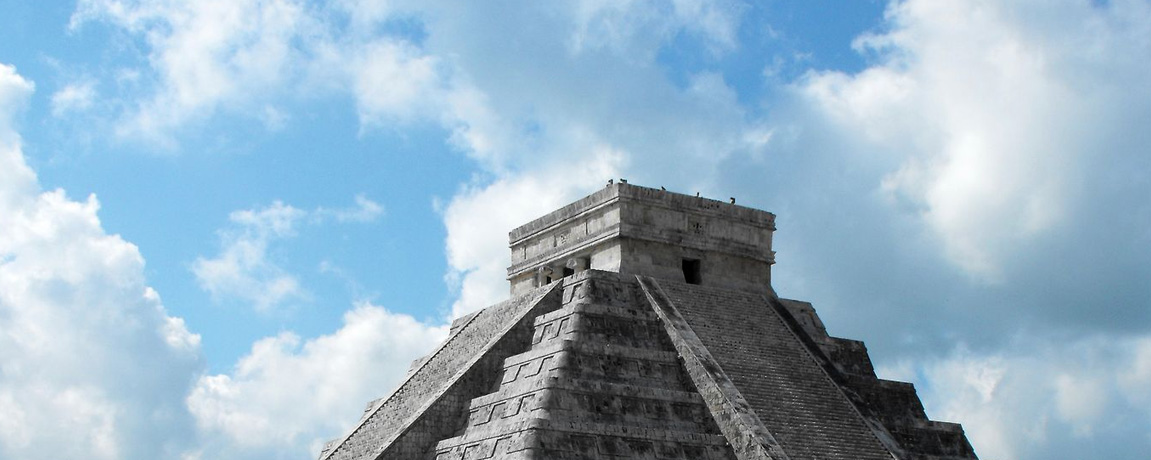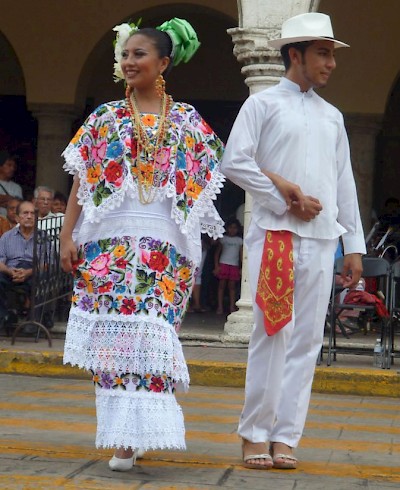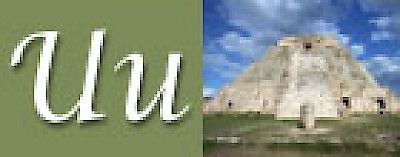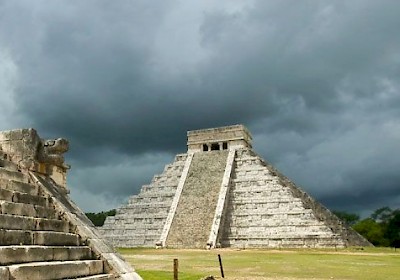The Yucatan Primer
Coming to Yucatan for the first time can be a bit like learning to read. So much is so new. In service to this metaphor, we present to you our version of a Yucatan Primer... an introduction to Yucatan for new arrivals. This article was cited in a newspaper in Seattle as something good to read to get the most out of your Yucatan trip... we couldn't agree more! We updated it in 2015, but frankly there was not much to change... the iconic things about the Yucatan do not change much. Hopefully, with sustainable tourism and other respectful living, we can keep it that way.
****
A is for Ake. Hacienda Ake has a working henequen processing plant, called a casa de maquina, that they fire up every so often to produce twine. You can see the whole operation from start to finish, but don't expect a Disney-style tour. It's a sleepy town and you get to poke around the hacienda and the machinery. Right next door is the Mayan archeaological zone of the same name, with rows of mysterious stone columns and a beautiful view. Hacienda Ake can be reached off the main Merida-Cancun highway (Autopista 180). You can read more about henequen and haciendas.
B is for Birdwatching. The Yucatan Peninsula plays host to hundreds of different bird species that either live here or are just passing through on their seasonal migration. If birdwatching is your thing, check out the Annual Festival de Aves held every year in Merida. And now Campeche has its own annual birdwatching events as well.
C is for Cenote. The fresh-water springs that dot the Yucatan Peninsula and are usually found underground. There are no above-ground rivers in Yucatan state, but many below ground that connect the cenotes. You can dive or snorkel or swim in some of the cenotes, and they have always been a source of fresh water for the Maya. There is nothing better on a hot day than a cool, crystal-clear cenote. Except maybe a frosty cold Mexican Coca-Cola. Put the two together for nirvana. Before you go, watch this video of our adventure at a cenote near Chichen Itza (which also starts with a C, by the way).
D is for Diving. Scuba diving off the coast of Cozumel, Cancun, Playa del Carmen, Tulum and Xcalak is some of the best in the world. The world's second largest barrier reef runs all the way down the coast of the Mayan Riviera and features beautiful formations of coral and a bevy of exotic tropical fish. The water in the Caribbean is somewhere in the high 70's or low 80's all year round, and the visibility can reach 100-125 feet. Add to that the opportunity to dive in cenotes all across the peninsula, and you can see why the Yucatan Peninsula is a scuba diver's dream.
E is for Eco-Resorts. There are plenty of places to stay in the Yucatan to immerse yourself in local ecology without completely giving up creature comforts. Whether you are going to Celestun to see the flamingos, Tulum for some Caribbean R&R or Chichen Itza to visit the Mayan past, there is an eco-resort for you. These places pride themselves on low impact environmental standards and are an important part of the tourist industry.
F is for Flamingos. As kids, we thought we'd have to go to Africa on a safari to see these pink-feathered wonders, but now we just drive down to Celestun or Telchac Puerto and see them in droves. The Yucatan is a favorite hang-out for flamingoes, and there is something about their color and size and general design that make them a real viewing pleasure. If you are lucky enough to get close to them, please conduct yourself with quiet humility. We want these creatures to continue to grace our coastal waters for a very long time to come.
G is for Gulf Coast. The Gulf Coast along the northern shores of the Yucatan Peninsula is one of the world's undiscovered treasures. Stretches of undeveloped beaches, mangrove cienagas, freshwater springs and coconut groves combine to create a vacation area that is quieter and more remote than the Mayan Riviera, but still just an hour or less from Merida. Real estate prices on the Gulf Coast of the Yucatan, in places like Progreso, Chelem, Chuburna and Telchac are rising steadily and it won't be long before this area becomes a world-class destination. In the meantime, you can enjoy everything from a luxurious vacation rental to a eco-friendly hammock between two palm trees here... and still be only a half hour from Merida!
H is for Hacienda. There are over 170 haciendas throughout the Yucatan Peninsula. Some have fallen into ruin, some have been beautifully renovated. Some are hotels, others are private homes. We've even heard recently of one that grows bamboo and fresh-water fish! We have photographed over 30 different haciendas and some of our photographs can be seen in this article on Haciendas in the Yucatan and in the Photo Gallery.
I is for Islands... there are a few special ones just off the coast of the Yucatan. The most well-known is Cozumel, a must-do for scuba divers and a major destination for cruise ships. Rent a moped and visit the Rasta Bar on the island's southern tip. Isla Mujeres is a charming island east of Cancun where we go for the same beautiful weather as the Mayan Riviera without the crowds or cars. There are lovely hotels, ranging from budget to luxury and nice walk streets for shopping and strolling, with wide safe beaches on the north side and snorkeling and diving on the south side. And it is also a pleasant ferry ride to get there. Isla Holbox, just north of Cancun, is even more remote and quiet. We have eaten the best ceviche de camarones (shrimp ceviche) and an incredibly fresh and inexpensive lobster there... we still talk about it years later, that's how good it was! Take a lancha (boat) out to Isla de Pajaros (Bird Island) at sunset to watch the birds come home to roost.
J is for Jungle. Depending on where you are on the Yucatan Peninsula, the jungle is either a scrubby, dry monte or the dripping wet viridian selva that most of us imagine when we hear the word. Check out Jim Conrad's fascinating website about Yucatan Plants, Animals and Ecology for more on the natural wonders of Yucatan.
K is for Kukulcan, the feathered serpent god that was revered by the ancient Maya. His likeness and name have been adopted by the Mayan Riviera in particular, and now he can be seen on everything from the main boulevard in the Zona Hotelera in Cancun to countless hotels and restaurants all up and down the coast. Probably his most famous appearance is during the equinox as a shadow on the steps of the famous pyramid of Kukulcan at Chichen Itza.
L is for Lluvia de Oro. These graceful trees are ubiquitous in the Yucatan and during the spring months they live up to their name (rain of gold) by dripping with bright yellow blossoms. Yucatecos tend to plant them alongside Flamboyanes trees, which burst into bright red blooms about the same time, making for a multicolored canopy along many of the boulevards and streets.
M is for Mayab, the land of the Maya, and for its people, the native Yucatec Maya. Despite what you may read or see on the Discovery Channel, they are not a lost civilization. They have always lived here. Their language, rituals, crafts and cooking still live, evolving over time to adapt to a changing world. The Spanish conquistadors were no match for Mayan patience, and Europeans who lived in Yucatan were almost driven off the Yucatan Peninsula by the Maya during the Caste Wars of the 19th century following centuries of mistreatment. The Maya are the largest surviving indigenous population in the Americas. Nearly everything you see or experience in Yucatan is influenced by their presence. Want to learn to speak their language? You can get a start Speaking Maya here.
N is for Naranja. Naranjas (oranges) grow well in the Yucatan, as do limes, grapefruit, papayas, mangos, pitayas, zapotes and a whole host of other tropical fruits you'll to want to try. Everywhere you go in the Yucatan, fresh orange juice or naranjada (orange juice with water) is easy to find. Be sure to take part in the eating adventure of trying fruits or vegetables you have never heard of... there are a lot of them. If you see something in the mercado, ask the vendor if you can buy one and then ask him or her to show you how to eat it.
O is for Oro, which means "gold" in Spanish. The funny thing about the Yucatan is that there are no natural deposits of gold here, nor any kind of metal. The absence of gold in Yucatan may explain why the invading Europeans did not completely destroy the native people and culture of this region as they did in other parts of the Americas.
P is for Pirates, frequent visitors to the Yucatan Coast in the 17th and 18th centuries. From Isla Mujeres to Campeche, pirates have influenced the area's history. This is abundantly obvious in Campeche, where the thick city walls and well-built forts that protected the city from pirates are now open to the public as museums. Downtown Campeche has been renovated to perfection, and a humid summer night in Campeche has left the Working Gringos thinking about Disneyland's Pirates of the Caribbean more than once. Pirates are called piratas in Spanish, which is also the word used for those illegal CDs and DVDs that are hawked on the streets in the city.
Q is for Quiet, something that is a lot easier to find in the Yucatan than in other places around the world. Whether it is the quiet of swinging in a hammock at siesta-time in a tropical garden or the quiet of walking along miles of empty beach at sunrise, Yucatan can deliver quiet to soothe the jangled soul.
R is for the Riviera Maya, the crown jewel of Mexican tourism. It's no wonder why 14.2 million people (in 2014) and counting visit this part of the world every year. The soft white sandy beaches, the clear Caribbean water and the deep blue skies draw visitors over and over again... and may have a lot to do with why some of us moved here! The Riviera Maya has hotels to rival any in the world, from beach palapas to five-star luxury suites. And everywhere you go, the relaxed and friendly spirit of the Yucatan prevails.
S is for Sian Ka'an Biosphere. The Mexican government thoughtfully set aside hectares y hectares of land and beachfront for the animals and for future generations. This area is a huge swath of land south of Tulum. Take a tour inside the Biosphere with the official tour company, Sian Kaan Ecotours. Or drive yourself down to the CESiak's headquarters and have lunch, tour the grounds and get a great view from their overlook tower.
T is for Trova. Most people outside the Latin world don't know that Yucatan is famous for its music. Yucatecan music is generally called Trova, which simply means "song". Popular styles include Bambuco Yucateco, imported from Columbia, as well as the Bolero and Clave, both from Cuba. The Yucatecan sound has an innocent, romantic and lyrical melody composed for voice. It is usually played by a trio of male singers with guitars, called Trovadores, but more elaborate compositions can include female background singers and a small orchestra. The most famous Yucateco singer was probably Guty Cárdenas (1905-1932), but many have followed his lead with increasing technical skill. Folk music composed for dance, like La Jarana, is also poplular. If you have never heard the music of Yucatan, then you're in for a treat when you visit our Music page. And you might also want to visit the Museo de la Canción in Merida.
U is for Uxmal, perhaps the most beautiful (though not the most famous) of the Mayan archeaological zones scattered throughout the Yucatan Peninsula. Uxmal is just forty minutes south of Merida and features some of the most graceful and astounding stone structures in the Mayan world. Other sites not to be missed include Mayapan, Ek Balam, Edzna, Dzibilchaltun and of course, the most famous one: Chichen Itza.
V is for vaya bien. Which is a shortened version of the Spanish, que te vayas bien, which means "that you go well". It's the Yucatecan version of "have a nice day" but with a bit more reverence. Learning a second language such as Spanish - with a little Mayan thrown in for good measure - is another great benefit of living in Yucatan. We have come to realize that English alone cannot possibly express all of life's experiences. Want to learn Spanish while you are in Merida? Check out our listing of places to learn to speak Spanish there...
W is for Whale Sharks. Yep, the Yucatan even has Whale Sharks, those gentle giants of the sea and the holy grail for some scuba divers. Whale Sharks regularly appear off the island of Holbox once a year when that area, known as the Tres Aguas where the Gulf, the Atlantic and the Caribbean meet, becomes a feeding ground filled with yummy plankton. We first discovered this years ago, before there was a formal program. Now, the government trains and monitors the boat drivers that take tourists to see the Whale Sharks. If you go, please use an official guide and don't do anything to harm these beautiful animals. Once you've snorkled with fish that are as big as a schoolbus, your life will never be the same!
X is for Xcalak, Xcaret, Xpu-Ha, Xcanatun, Xel-Ha and dozens of other locations on the Yucatan Peninsula that start with the letter "X". In the Mayan language, "X" is pronounced "ish" if it's at the beginning of a word and "sh" if it's in the middle of a word. We wonder if there is any other place in the world where there are so many place names that start with the letter "X"?!
Y is for Yucatecan Cuisine, some of the most interesting and exotic food on the planet today. Yucatecan dishes are fresh, flavorful and very different from what most people think of as Mexican food. Find out more about Yucatecan food in our section on regional cuisine, which includes some great recipes!
Z is for Zorros. Yes, zorro means "fox" in Spanish, but zorro in the Yucatan means "opossum". There are opossums even in downtown Merida. They can climb walls and ladders (going down head-first) and seem impervious to the onslaught of modern life. Mayans don't like them at all, but we think they are kind of cute... in a prehistoric way.
Congratulations, you've read through the Yucatan Primer. Now you know more than most people about this special corner of the world!




































Comments
18 years ago
Is there snorkling close to the shore or do you always have to take a boat to the reef?
Reply
Working Gringos 18 years ago
You're right, Ray. It's an optical illusion. That's not an island on the horizon; it's a rock outcropping from shore that's about fifty yards away, taken on Isla Mujeres.
Reply
Roy 18 years ago
Where is the picture with the word Island? Does not look like any of the islands in the Yucatan. They are usually pretty flat. Please correct me if I am wrong.
Reply
Roy 18 years ago
And I thought I knew all there was to know about the Yucatan. I keep getting amazed by your appreciation of the land you have adopted as home. Wondeful primer and a good reminder of the beauty of all the Mayab.
Reply
Carlos Daniel Gallegos 18 years ago
How I learned about Merida and The Yucatan.
1) Mi esposa, Ariadna, 100% Yucateca, who works for La Museo De La Ciudad in Centro. She helped me to know what places to eat at, what bargins to find, and got me on her hospital at IMSS.
2) The Camions Urbanos. For just $4.50 pesos, I hopped on the different routes and went all over Merida. I rode the different buses. Minnis 2000, the air conditioned Pioneros de Confort, Rojos, Iberica, and other routes. Visit Uman and Cholul and Chi Chi Suarez on those buses.
3) I sat in Plaza Grande Parque, every day, while waiting on my wife to get off work. I sat in front of the Govoner's Palacio. Observing different people. Their clothing, shoes, hearing their languages. Observing the wide eyed tourists and the women of Chiapas. Watching the modern school kids as they copied the American music videos in their style of dress and actions. The tradional Yucatecans.
4) Talking to the people on the street, the bus drivers, the shop keepers, resturant workers.
5) Eating at the Cocina Economicas in the Colonias, talking to the down to earth Yucatecos.
This is but a few ways I learned about Merida and The Yucatan.
Reply
Marie Garcia 18 years ago
Beautiful article both in the writing and the graphics!!!!! Very informative, keep it up, I'm really learning a lot of my future home. :)
Reply
« Back (20 to 26 comments)